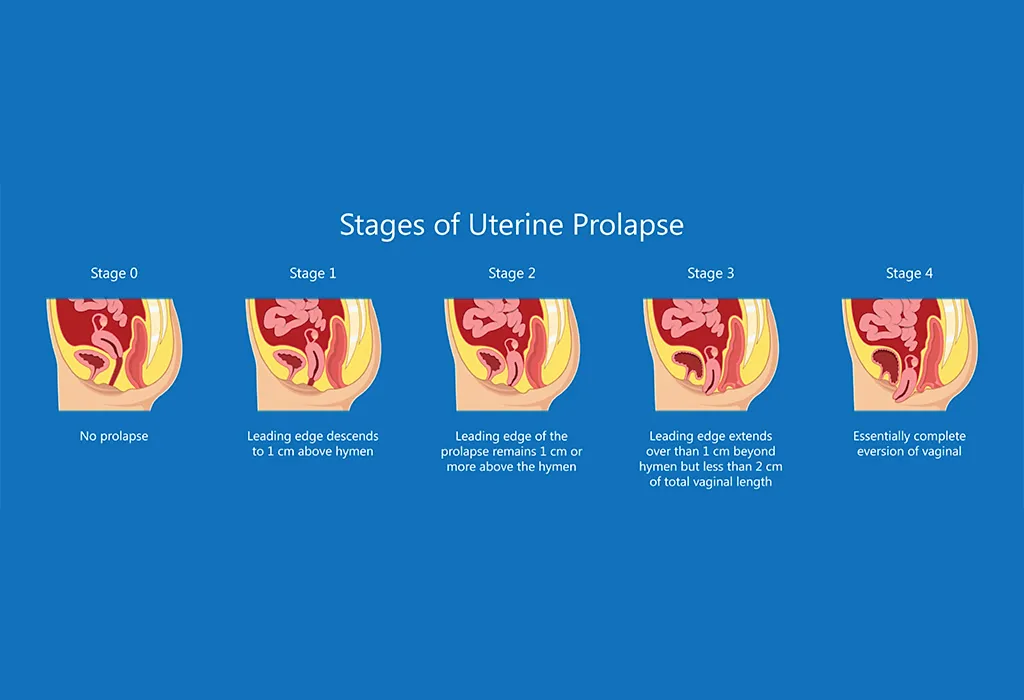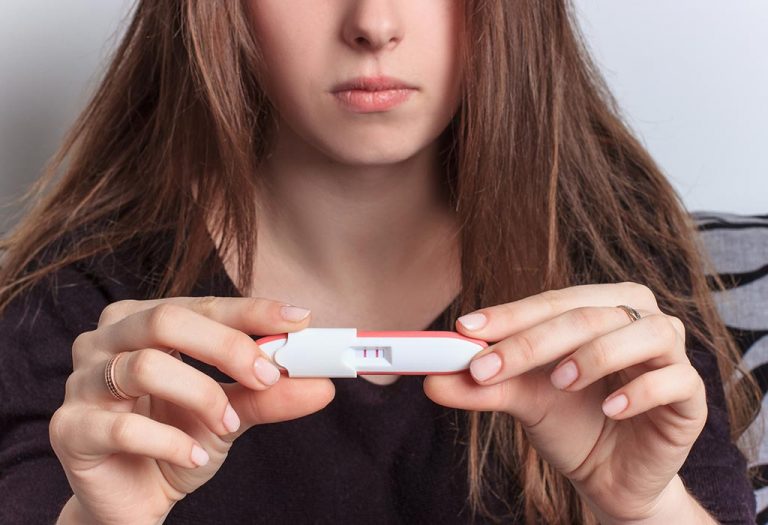Uterine Prolapse in Pregnancy – Causes, Symptoms and Treatment
Helping moms understand uterine prolapse in pregnancy with its types, stages, risks, and safe management tips.

- What Is Uterine Prolapse in Pregnancy?
- Types of Uterine Prolapse
- Different Stages of Cervical Prolapse
- Causes of Uterine Prolapse in Pregnancy
- Signs & Symptoms of Uterine or Cervical Prolapse
- Who Is at Risk of Cervical Prolapse?
- What Are the Complications of Pregnancy Uterine Prolapse?
- Diagnosing Uterine Prolapse While Pregnant
- Treatment for Uterine Prolapse in Pregnant Women
- Can Pelvic Floor Muscle Exercises Really Help?
- How Soon Can Floor Muscle Exercises Help to Improve Uterine Prolapse?
- How Can You Prevent Uterine or Cervical Prolapse?
- Common Myths About Pregnancy Prolapse
- FAQs
Pregnancy can affect a woman in many unexpected ways. The fluctuating hormones, physiological and psychological changes that a pregnant woman goes through can give rise to certain issues. One such incidence can be the development of uterine or cervical prolapse during pregnancy.
Although a rare event, uterine prolapse during pregnancy can prove dangerous for both the mom and her baby. It can trigger problems like cervical infections, haemorrhaging, preterm labour and even miscarriage. Its treatment may involve surgical interventions, which can further expose a pregnant woman to added risks. Therefore, the best course of action can be to undertake preventive measures to avoid any likelihood of uterine prolapse in pregnancy. So, let’s read on to understand all about pregnancy and prolapsed uterus.
What Is Uterine Prolapse in Pregnancy?
The uterus (womb) of a woman, which holds the unborn baby, is a muscular form that’s usually supported inside her pelvis by many tissues, muscles, and ligaments. Certain factors during pregnancy can cause these muscles and ligaments to weaken, relax or stretch. Lack of enough support may cause the uterus to leave its location and descend into the vagina or the birth canal. This medical condition of the fallen womb is called uterine prolapse or cervical prolapse. However, it may be significant to take into consideration that the incidence of uterine prolapse during pregnancy is not a common occurrence (1).

Types of Uterine Prolapse
Uterine or cervical prolapse commonly is of two sorts:
1. Complete Uterine Prolapse
A complete prolapse happens when the uterus drops down so far that some part of the uterus may project out of the vaginal opening.
2. Incomplete Uterine Prolapse
An incomplete prolapse ensues when the uterus partially falls into the vagina but does not come through.
Different Stages of Cervical Prolapse

Muscle relaxation or weakness may let the uterus dip down partly or completely out of the vagina in different stages. The different stages indicate the extent to which the uterus has descended (2).
- First Stage: During this stage, the cervix slumps into the upper vagina.
- Second Stage: In this stage, the cervix descends to a level close to the vagina’s opening.
- Third Stage: In this state, the cervix slides outside the vagina.
- Fourth Stage: In this condition, the uterus is totally out of the vagina.
Causes of Uterine Prolapse in Pregnancy
Some of the causes of uterine prolapse in pregnancy can be (4):
- Obstetric history of large babies or difficult deliveries
- Congenital connective tissue syndrome
- Excessive weight gain during pregnancy
- Previous childbirth trauma resulting in weak pelvic floor muscles
- Augmented intrabdominal pressure
- Severe coughing due to asthma or bad bronchitis
- Overstraining because of constipation
- A pelvic tumour or fibroids
- Past surgery in the pelvic part leading to weakening of muscles
- Physiological variations owing to hormonal changes prompting cervix softening
Signs & Symptoms of Uterine or Cervical Prolapse
A few signs and symptoms of uterine prolapse can be (5):
- A constant feeling of heaviness in the perineum
- Increased discharge from the vaginal introitus (during the second trimester)
- Some tissue protruding out of the vagina
- Urinary issues like urine retention or urine leakage
- Difficulties having bowel movements
- Having a feeling of sitting on a tiny ball or a sinking feeling like something is dropping out of the vagina
- Sexual concerns, like experiencing trouble while having sex or a feeling of looseness in the vaginal tissue
If you notice any of the above symptoms of a prolapsed uterus during pregnancy, please visit your doctor at the earliest.
Who Is at Risk of Cervical Prolapse?
Not enough scientific literature is available on cervical prolapse because it occurs rarely. It may be difficult to say why some pregnant women develop this condition. However, factors like advanced age of the pregnant woman, BMI, increased intra-abdominal pressure, and history of congenital weakness of pelvic muscles may put some pregnant women at a greater risk of cervical prolapse. Also, a woman who may have suffered pelvic trauma during a difficult delivery or prolonged labour in her earlier vaginal delivery is also at an increased risk. The changing pregnancy hormones may result in increased levels of progesterone, cortisol, and relaxin in some cases, triggering hypertrophic cervical elongation, which can adversely affect the pelvic floor muscles holding the uterus and provoke cervical prolapse.

What Are the Complications of Pregnancy Uterine Prolapse?
Some of the complications of pregnancy uterine prolapse can be (3):
- Minor cervical infection
- Acute urinary retention
- Urinary tract infection
- Preterm labor
- Miscarriage
- Risk of dystocia (obstructed labour) during delivery
- Uterine rupture causing fetal death and maternal mortality
- Ulceration of the visible tissue
- Prolapse of other organs, like the rectum or the bladder
Diagnosing Uterine Prolapse While Pregnant
Your doctor may make a diagnosis of cervical or uterine prolapse when pregnant during a pelvic examination by inserting a speculum, which will allow him to check the vagina and uterus. During the pelvic inspection, your doctor may also ask you to push down as if experiencing a bowel movement. Doing so may help your doctor evaluate how far down the uterus has fallen into the vagina. He may also ask you to stiffen the muscles of your pelvis as if you are controlling the flow of urine to ascertain the strength or firmness of the pelvic muscles (6).
Treatment for Uterine Prolapse in Pregnant Women
The course of treatment for a prolapsed uterus when pregnant usually depends on the severity of the specific case. Your doctor may suggest the following:
- Inserting a vaginal pessary, a rubber ring, to provide support to sagging tissues (7). The pessary may need periodic removal for cleaning.
- In severe cases, doctors may recommend laparoscopic surgery for uterine prolapse.
- In specific situations, an elective cesarean section followed by a peripartum hysterectomy may be considered.
- Some cases may benefit from specialised physical therapy to strengthen pelvic floor muscles and support structures.
- Pregnant women with uterine prolapse may require regular check-ups and monitoring throughout pregnancy to assess the progression of the condition and adjust the treatment plan accordingly.
Can Pelvic Floor Muscle Exercises Really Help?
Pelvic floor strength training or Kegel exercises can prove useful in not only preparing women for delivery but also in alleviating the symptoms of uterine prolapse. Studies indicate that women who regularly practise pelvic floor muscle exercises can avert most of the problems associated with cervical prolapse. Therefore, every expectant mother may find it helpful to make these exercises a part of their daily exercise regimen.

How Soon Can Floor Muscle Exercises Help to Improve Uterine Prolapse?
Women who have mild uterine prolapse can perform floor muscle exercises to tackle the symptoms and support their pelvic floor, which may help reverse the development of the condition. It is important to regularly perform them and use proper techniques for the exercises to be effective.
How Can You Prevent Uterine or Cervical Prolapse?
Here are some handy tips which may help you prevent prolapsed womb in pregnancy:
- Do regular Kegel exercises to toughen your pelvic floor muscles, which may help thwart the occurrence of a prolapsed cervix while pregnant.
- Drink adequate amounts of water and healthy fluids, including high-fibre foods like green vegetables, fruits, and whole-grain cereals in your diet, which may regulate bowel movements and prevent constipation.

- This is one of the most important tips to prevent cervical prolapse during pregnancy. Avoid lifting heavy stuff. In case you need to lift, bend your legs instead of bending from the waist or back.
- If you suffer from bronchitis, treat it as soon as possible.
- Keep a check on weight gain. You can consult a dietician for weight-loss strategies if necessary.
Common Myths About Pregnancy Prolapse
Misconceptions about pregnancy prolapse can lead to unnecessary anxiety and misinformation. Let’s debunk common myths surrounding this condition to ensure an accurate understanding and promote informed health decisions during pregnancy.
1. Myth: Pregnancy Prolapse Only Happens After Multiple Pregnancies
Some believe that prolapse occurs only after multiple pregnancies. In reality, it can happen in any pregnancy due to various factors like genetics, hormonal changes, and lifestyle.
2. Myth: Exercise During Pregnancy Causes Prolapse
Contrary to the belief that exercise contributes to prolapse, appropriate and supervised exercise can enhance pelvic floor strength, reducing the risk of prolapse.
3. Myth: C-Sections Eliminate the Risk of Prolapse
While C-sections can reduce certain risks, they don’t guarantee immunity from prolapse. Factors like genetics and lifestyle play significant roles.
4. Myth: All Women Experience Prolapse During Pregnancy
Prolapse is not universal during pregnancy. While it can occur, its occurrence varies among women, emphasising the importance of individualised care.
5. Myth: Prolapse Is Always Accompanied by Pain
Not all cases of prolapse involve pain. Some women may experience discomfort, while others may be asymptomatic. Symptoms vary widely.
6. Myth: Surgery Is the Only Treatment Option for Prolapse
Non-surgical interventions, such as physical therapy and lifestyle modifications, are effective in managing and preventing prolapse. Surgery is reserved for severe cases.
FAQs
1. Is it safe to have a vaginal delivery with uterine prolapse?
Vaginal delivery may be safe in some cases of uterine prolapse, but it depends on the severity of the condition. Your healthcare provider will assess individual factors and recommend the safest delivery method for you and your baby.
2. Can uterine prolapse during pregnancy have an effect on future pregnancies?
Uterine prolapse during pregnancy may impact future pregnancies, but the degree varies. Adequate management and follow-up care can mitigate risks. Consult with your healthcare provider to discuss individual considerations and potential effects on future pregnancies.
3. Can the prolapsed uterus affect fetal positioning (e.g., breech) or engagement during labour?
Yes, it is a possibility, though not a certainty. A significantly prolapsed uterus can alter the shape and orientation of the uterine cavity. This atypical positioning may provide less room for the fetus to manoeuvre into the standard head-down (vertex) position, potentially increasing the risk of a breech or transverse lie. Furthermore, the descent of the uterus itself can act as a physical barrier, preventing the baby’s head from properly engaging in the mother’s pelvis in the final weeks of pregnancy.
So, this was all about uterine prolapse and pregnancy. Managing the physical demands of pregnancy can be challenging, and being pregnant with a prolapse requires careful monitoring and specific lifestyle adjustments to ensure the health of both mother and baby. Adopting a healthy lifestyle by expectant moms may help them reduce their chances of developing uterine prolapse. Regular exercise, a nutritious diet, and an active routine may facilitate a smooth pregnancy and a safe delivery.
Also Read:
Uterine Abnormalities
Umbilical Cord Prolapse
Uterine Fibroids During Pregnancy
Uterus Inversion – Reasons, Signs & Treatment
Was This Article Helpful?
Parenting is a huge responsibility, for you as a caregiver, but also for us as a parenting content platform. We understand that and take our responsibility of creating credible content seriously. FirstCry Parenting articles are written and published only after extensive research using factually sound references to deliver quality content that is accurate, validated by experts, and completely reliable. To understand how we go about creating content that is credible, read our editorial policy here.
1. National Library of Medicine – Uterine Prolapse in Pregnancy: Two Cases Report and Literature Review
2. National Library of Medicine – Uterine Prolapse
3. Pan African Medical Journal – Uterine prolapse in pregnancy: a case report and literature review
4. Department of Health & Human Services, State Government of Victoria, Australia – Prolapsed uterus
6. Johns Hopkins Medicine – Uterine Prolapse
























